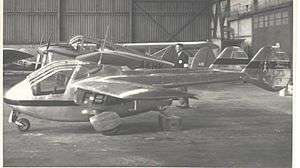SIPA S.200 Minijet
The SIPA S.200 Minijet was a French two-seat light sporting jet aircraft, with a single engine jet. This small jet is designed for liaison, training, and aerobatics during 1950s.
| S.200 Minijet | |
|---|---|
 | |
| F-BGVM at Leeds (Yeadon) Airport in May 1955 after giving an aerobatic display | |
| Role | Light sporting jet |
| National origin | France |
| Manufacturer | Societe Industrielle Pour l'Aeronautique (SIPA) |
| First flight | 14 January 1952 |
| Status | two survivors |
| Number built | 7 |
Design and development
The Minijet was built by the Société Industrielle Pour l’Aéronautique (SIPA), which had been founded during 1938 by Emile Dewoitine. The design of the aircraft was begun in February 1951 by Yves Gardan. The first of two prototypes made its maiden flight on 14 January 1952.[1] The SIPA S. 200 was claimed by its manufacture to be the world's first jet powered light touring aircraft.[2]
A pre-production batch of five Minijets was completed in 1955/56, but plans for further construction were cancelled. The Minijet was designed for the dual role of high-speed, short-range liaison and transitional training.
The aircraft had a shoulder-wing and twin booms supporting vertical stabilisers with a tail plane joining the two booms. The cabin was located in the central fuselage nacelle and accommodated two persons side-by-side. The entire canopy hinged forward to assist access to the small cabin. The second prototype was fitted with attachment points for auxiliary wingtip fuel tanks. The Minijets were stressed for aerobatics. Power was by a single 330 lb s.t. Turbomeca Palas jet engine.[1]
Survivors
The final production SIPA Minijet F-PDHE is owned by the Collection Bezard at Persan-Beaumont Airport NW of Paris and can be seen by prior arrangement only.[3] Another survivor exists in the USA.
Specifications
Data from [1]
General characteristics
- Crew: 2
- Length: 5.18 m (17 ft 0 in)
- Wingspan: 8.0 m (26 ft 3 in)
- Height: 1.78 m (5 ft 10 in) [4]
- Wing area: 9.6 m2 (104 sq ft) [4]
- Empty weight: 523 kg (1,153 lb)
- Gross weight: 880 kg (1,940 lb)
- Powerplant: 1 × Turbomeca Palas , 1.5 kN (330 lbf) thrust
Performance
- Maximum speed: 398 km/h (248 mph, 216 kn)
- Cruise speed: 358 km/h (223 mph, 194 kn)
- Range: 563 km (350 mi, 300 nmi) without tip-tanks
- Service ceiling: 7,927 m (26,000 ft)
- Rate of climb: 5.75 m/s (1,140 ft/min) [4]
References
| Wikimedia Commons has media related to SIPA S.200 Minijet. |
- Notes
- Green 1956, p. 170
- "French Built Jet Powered Light Touring Plane" Popular Mechanics, July 1952, p. 134.
- Ogden 2006, p. 187
- Bridgeman 1956, p. 158
- Bibliography
- Green, William (1956). The Aircraft of the World. Macdonald & Co. (Publishers) Ltd.
- Ogden, Bob (2006). Aviation Museums and Collections of Mainland Europe. Air-Britain (Historians) Ltd. ISBN 0-85130-375-7.
- Bridgeman, Leonard (1956). Jane's all the world's aircraft 1956–7. Jane's all the world's aircraft Publishing Co. Ltd.
- Stroud, John (30 October 1953), "Baby Jet: Flying the Sipa 200 Minijet", Flight